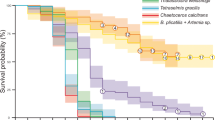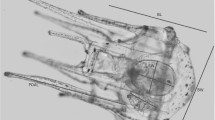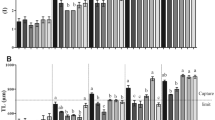Abstract
Attempts to breed crustacean species of commercial interest to promote the conservation, restoration and enhancement of the stocks are increasing. Optimization of diet for larval growth is a crucial step for successful actions. Here we focus on the caramote prawn (Penaeus kerathurus), a primary target of small-scale fishery because of its high commercial value in the North Mediterranean region and particularly in Italy. Three species of microalgae (Isochrysis galbana, Nannochloropsis oculata, and Chaetoceros calcitrans) with different fatty acid contents were used to feed caramote prawn larvae as monospecific diets. Further, C. calcitrans in combination either with I. galbana or N. oculata were tested as mixed diets. Measurements of developmental performance were taken until the larvae metamorphosed to Mysis 1, while survival rate was estimated at day 10 of benthonic post-larval stage. Larvae fed on mixed diets performed as well or slightly better than those fed on single-C. calcitrans and -N. oculata diets both in terms of development and survival, while larvae fed with I. galbana diet performed worse overall. Diets that performed best (C. calcitrans and I. galbana mix) are known to have a higher proportion of the essential fatty acids eicosapentaenoic acid (EPA, 20:5n-3) and docosahexaenoic acid (DHA, 22:6n-3), respectively. We suggest that mixed-algal diets could improve the performance of larvae by providing a wider availability of fatty acids.




Similar content being viewed by others
References
Agnalt A-L, van der Meeren GI, Jørstad KE, Næss H, Farestveit E, Nøstvold E, Korsøen E, Ydstebø L, Svåsand T (1999) Stock enhancement of European lobster (Homarus gammarus): a large-scale experiment off southwestern Norway (Kvitsøy). In: Howell B, Moksness E, Svåsand T (eds) Stock enhancement and sea ranching. Blackwell Scientific Press, London, pp 401–419
Arcos FG, Ibarra AM, Palacios E, VazquezBoucard C, Racotta IS (2003) Feasible predictive criteria for reproductive performance of white shrimp Litopenaeus vannamei: egg quality and female physiological condition. Aquaculture 228:335–349
Arculeo M, Pellerito R, Lo Brutto S, Bonhomme F (2011) Uso di marcatori molecolari per lo studio della variazione genetica di Melicertus kerathurus (Crustacea, Decapoda). In: La Risorsa Crostacei nel Mediterraneo: ricerca, produzione e mercato. Atti del Convegno, Veneto Agricoltura, pp 84–89
Aspaas S, Grefsrud ES, Fernö A, Jensen K, Trengereid H, Agnalt AL (2016) An enriched environment promotes shelter-seeking behaviour and survival of hatchery-produced juvenile European lobster (Homarus gammarus). PLoS One 11:e0159807
Bannister RCA, Addison JT, Lovewell SRJ (1994) Growth, movement, recapture rate and survival of hatchery-reared lobsters (Homarus gammarus (Linnaeus, 1758)) released into the wild on the English East Coast. Crustaceana 67:156–172
Becker W (2004) The nutritional value of microalgae for aquaculture. In: Richmond A (ed) Handbook of microalgal culture: biotechnology and applied phycology. Blackwell Science Ltd, London, pp 380–381
Brown MR (1991) The aminoacid composition of 16 species of microalgae used in mariculture. J Exp Mar Biol Ecol 145:79–99
Brown MR (2002) Nutritional value of microalgae for aquculture. In Cruz-Suárez LE, Ricque-Marie D, Tapia-Salazar M, Gaxiola-Cortés MG, Simoes N (eds) Avances en Nutrición Acuícola VI. Memorias del VI Simposium Internacional de Nutrición Acuícola. 3 al 6 de Septiembre del 2002. Cancún, Quintana Roo, México
Brown MR, Jeffrey SW, Garland CD (1989) Nutritional aspects of microalgae used in mariculture: a literature review. CSIRO Marine Laboratories Report 205
Cannizzaro L, Vitale S, De Stefano G, Lumare D, Arculeo M, Milazzo A (2011a) I decapodi bersaglio della flotta artigianale tra Capo Granitola e Capo San Marco (costa sud occidentale siciliana). In: La risorsa Crostacei nel Mediterraneo: ricerca, produzione e mercato. Atti del convegno, Veneto Agricoltura, pp 96–102
Cannizzaro L, Vitale S, Arculeo M, De Stefano G, Lumare L, Milazzo A (2011b) Stock assessment and management by restocking of Melicertus kerathurus (Forskäl, 1775) in the shallow coastal waters at Selinunte. J Coast Res SI 64:1941–1945
Carere C, Nascetti G, Carlini A, Santucci D, Alleva E (2015) Actions for restocking of the European lobster (Homarus gammarus): a case study on the relevance of behaviour and welfare assessment of cultured juveniles. Rend Fis Acc Lincei 26:59–64
Chu KH and Lui LK (1990) Survival and development of Metapenaeus ensis larvae reared on algal and artificial diets. In: Hirano R, Hanyu I (eds) The second asian fisheries forum. Asian Fisheries Society, Manila, pp 391–394
Conides A, Glamuzina B, Jug-Dujakovic J, Papaconstantinou C, Kapiris K (2006) Age, growth, and mortality of the caramote shrimp, Melicertus kerathurus (Forskål, 1775) in the East Ionian Sea (Western Greece). Crustaceana 79:33–52
Conides A, Klaoudatos D, Papacostantinou C (2011) Changes in the biology and the production of Melicertus kerathurus: the case study in Amvrakikos Gulf (western Greece). In: La risorsa crostacei nel Mediterraneo: ricerca, produzione e mercato. Atti del convegno, Veneto Agricoltura, pp 16–26
Cook HL (1967) A method of rearing penaeid shrimp larvae for experimental studies. FAO Fish Rep 57:709–715
Crocos PJ, Coman GJ (1997) Temporal and age variability in the reproductive performance of Penaeus semisulcatus broodstock: optimising broodstock selection. Aquaculture 155:55–67
D’Souza FML, Loneragan N (1999) Effects of monospecific and mixed-algae diets on survival, development and fatty acid composition of Penaeid prawn (Penaeus spp.) larvae. Mar Biol 133:621–633
FAO (2007) FAO yearbook. Fishery statistics. Capture Production 2005. Vol 100/1 Rome, p 539
Guillard RRL (1975) Culture of phytoplankton for feeding marine invertebrates. In: Smith WL, Chanley MH (eds) Culture of marine invertebrate animals. Plenum Press, New York, p 34
Herrnkind WF, Butler MJ (1994) Settlement of spiny lobster, Panulirus argus (Latrielle, 1804), in Florida: pattern without predictability. Crustaceana 67:46–64
Jones DA, Kanazawa A, Abdel Rahman S (1979) Studies on the presentation of artificial diets for rearing the larvae of Penaeus japonicus Bate. Aquaculture 17:33–43
Jones DA, Kamarudin S, Le Vay L (1993) The potential for replacement of live feeds in larval culture. J World Aquac Soc 24:199–210
Kurmaly K, Jones DA, Yule AB, East J (1989) Comparative analysis of the growth and survival of Penaeus monodon (Fabricius) larvae, from protozoea 1 to postlarva 1, on live feeds, artificial diets and on combinations of both. Aquaculture 81:27–45
Liao IC (1985) A brief review of the larval rearing techniques of penaeid prawns. In: Taki Y, Primavera JH, Llobrera JA (eds) Proceedings of the First International Conference on the Culture of Penaeid Prawns/Shrimps, 4–7 December 1984, Iloilo City, Philippines, pp 65–78
Lumare F (1979) Reproduction of Penaeus kerathurus using eyestalk ablation. Aquaculture 18:203–214
Lumare F (2001) Studio sulla localizzazione di aree potenzialmente idonee alla gambericoltura in provincia di Cagliari. In: UNIRIGA (ed) 27 luglio 2001, Lecce, p 289
McConaugha JR (1992) Decapod larvae: dispersal, mortality, and ecology. A working hypothesis. Integr Comp Biol 32:512–523
Mourente G, Medina A, Gonzales S, Rodriguez A (1995) Variations in lipid content and nutritional status during larval development of the marine shrimp Penaeus kerathurus. Aquaculture 130:187–199
Narciso L, Morais S (2001) Comparative feeding behaviour of Penaeus kerathurus (Forskål, 1775) (Crustacea, Penaeidae) and Palaemon serratus (Pennant, 1777) (Crustacea, Palaemonidae) during larval development. Ciencias Marinas 27:559–575
Phillips BF, Melville-Smith R, Cheng YW (2003) Measuring the effects of pueruli removals and habitat improvement in assessing sustainability of spiny lobster populations. Fish Res 65:89–101
Piña P, Voltolina D, Nieves M, Robles M (2006) Survival, development and growth of the Pacific white shrimp Litopenaeus vannamei protozoea larvae, fed with monoalgal and diets. Aquaculture 253:523–530
Platon RR (1978) Design, operation and economics of a small-scale hatchery for the larval rearing of Sugpo, Penaeus monodon Fab. Aquaculture Department, Southeast Asian Fisheries Development Center, Tigbauan
Preston NP, Burford MA, Coman FE, Rothlisberg PC (1992) Natural diet of larval Penaeus merguiensis (Decapoda: Penaeidae) and its effect on survival. Mar Biol 113:181–191
Primavera JH (1985) A review of maturation and reproduction in closed-thelycum penaeids. In: SEAFDEC Aquaculture Department (ed) Proceedings of the first international conference on the culture of penned shrimps, Philippines, p 177
Racotta IS, Palacios E, Ibarra AM (2003) Shrimp larval quality in relation to broodstock condition. Aquaculture 227:107–130
Rodríguez A (1977) Contribución al conocimiento de la biología y pesca del langostino, Penaeus kerathurus (Forskål, 1775) del golfo de Cádiz (Región Sudatlántica española). Inv Pesq 41:603–635
Sànchez R (1986) Rearing of mysid stages of Penaeus vannamei fed cultured algae of three species. Aquaculture 58:139–144
Scordella G, Lumare F (2001) Stato delle popolazioni di Penaeus (Melicertus) kerathurus: valutazione dello sforzo di pesca e della produttivita nelle aree di Termoli (CB), Lesina (FG) e Frigole (LE). Stato della pesca e dinamica di popolazione del gambero mediterraneo Penaeus kerathurus in alcune aree della costa Adriatica. Proc. Int. Workshop, 16 Marzo, Lecce, Italy, pp 20–27
Schmalenbach I, Mehrtens F, Janke M, Buchholz F (2011) A mark-recapture study of hatchery-reared juvenile European lobsters, Homarus gammarus, released at the rocky island of Helgoland (German Bight, North Sea) from 2000 to 2009. Fish Res 108:22–30
Tobias-Quinitio E, Villegas CT (1982) Growth, survival and macronutrient composition of Penaeus monodon Fabricius larvae fed with Chaetoceros calcitrans and Tetraselmis chuii. Aquaculture 29:253–260
Villegas CT, Kanazawa A (1979) Relationship between diet composition and growth rate of the zoea and mysis stages of Penaeus japonicus Bate. Fish Res 4:32–40
Vitale S, Cannizzaro L, Lumare F, Arculeo M, Mazzola S (2013) Restocking trial of Melicertus kerathurus (Decapoda, Penaeidae) in the shallow coastal waters of Southwestern Sicily (Mediterranean Sea). Rapp Comm Int Mer Medit 40:794
Volkman JK, Jeffrey SW, Nichols PD, Rogers GI, Garland CD (1989) Fatty acids and lipid classes of ten species of microalgae used in mariculture. J Exp Mar Biol Ecol 128:219–240
Webb KL, Chu FE (1983) Phytoplankton as a food source for bivalve larvae. In: Pruder GD, Langdon CJ, Conklin DE (eds) Proceedings of the second international conference on aquaculture nutrition: biochemical and physiological approaches to shellfish nutrition, October 27–29, 1981, Lewes/Rehoboth Beach, Delaware. World Mariculture Society, Louisiana, pp 272–291
Yufera M, Rodriquez A, Lubian LM (1984) Zooplankton ingestion and feeding behavior of Penaeus kerathurus larvae reared in the laboratory. Aquaculture 42:217–224
Acknowledgements
We thank Dr. Mario Carere and Dr. Ines Lacchetti (Department of Health and Environment, Italian National Institute of Health, Rome) for providing the algae, and the Fishery Cooperative Harmine (Montalto Marina, Viterbo, Italy) for providing the wild females. European Fisheries Fund to Lazio and Calabria supported restocking actions of decapod crustaceans at the CISMAR. Alessandro Carlini provided invaluable technical support during all phases of the experiments. We thank four anonymous reviewers for their constructive criticisms and insightful suggestions that substantially improved the manuscript.
Author information
Authors and Affiliations
Corresponding author
Rights and permissions
About this article
Cite this article
Ciani, M., Carere, C. & Nascetti, G. Captive breeding of the caramote prawn (Penaeus kerathurus) for restocking purpose: effect of single- and mixed-algal diets on larval growth and survival. Rend. Fis. Acc. Lincei 29, 691–697 (2018). https://doi.org/10.1007/s12210-018-0728-1
Received:
Accepted:
Published:
Issue Date:
DOI: https://doi.org/10.1007/s12210-018-0728-1




